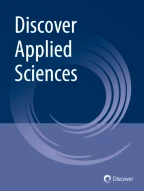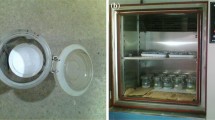
Calibration curve plays an important role in filter paper method because it affects accuracy in soil suction values. Osmotic coefficient and relative humidity govern the osmotic suction required to develop calibration curve and equation. Most of the researchers used the readily available total (osmotic) suction values from various studies to develop the calibration curve. Very few researchers used the osmotic coefficient in calibration and studied its effect on calibration and measuring suction. In this paper, the effect of the osmotic suction proposed by various researchers on calibration of Whatman 42 Filter paper was studied. Logarithmic and exponential calibration equations were developed and compared. The NaCl solution used in the present study provides limited total suction range of 0–30,000 kPa. The total suction of clayey soil was measured to validate the calibration curves proposed in this study. The feasibility of proposed osmotic coefficients is verified by measuring total suction of soil. The total suction estimated from calibration curve using osmotic coefficients was found to be more accurate.

Avoid common mistakes on your manuscript.
Due to unavailability of economical and easily available resources, measuring suction is hard to use in engineering practice which is the part of geotechnical engineering. The filter paper as a soil suction measuring resource is available in soil science which is simple, reliable and economical [1,2,3]. ASTM D 5298-94 [4] recommended filter paper method as a standard test for measuring soil suction. The trial operation is simple and sparing and does not need any extra equipment.
The dependability of the filter paper method is founded on understanding the principles and laboratory procedure followed. Essentially, the filter paper and soil reach equilibrium through vapour (total suction measurement) or liquid (matric suction measurement) flow. After reaching equilibrium, the soil suction is indirectly measured from the prior established calibration curve. Precise measurement of suction is governed by the accuracy of the filter paper water content versus the suction calibration curve [5,6,7]. The calibration curves are usually obtained from the processes of wetting the filter papers through vapour transfer (salt solutions) and drying the filter papers through fluid transfer (porous plates). For measuring total suction, the calibration curves are obtained from the wetting and drying process of the filter papers through vapour transfer (salt solutions). For measuring matric suction, the calibration curves are obtained from the wetting and drying of the filter papers through fluid transfer (porous plates). Total suction and pore fluid osmotic suction can be confidently determined using non-contact filter papers difference of which will give matric suction [8].
This paper is focusing on the total (osmotic) suction values used for calibration of filter paper by wetting process through NaCl salt solution. The calibration curves were developed by using water content of filter papers with total suction values.
Most of the researchers used the readily available total suction values from various studies to develop the calibration curve. Bulut et al. [5] used the total suction values prepared by Lang [9] to construct the calibration curve. ASTM D 5298 suggested to calculate the total suction value from the relative humidity by using Kelvin’s equation (Eq. 1) also provides a standard critical table giving relationship between salt concentration and relative humidity. Lu and Likos [10] used total suction calculated from relative humidity proposed by Bulut [11] for an unsaturated NaCl salt solution.
As osmotic coefficient and relative humidity govern the total suction required to produce a calibration curve and its equation, it is essential to study the performance of calibration curve. Most of the researchers have been applied the total suction values prepared by either Lang or combination of relative humidity and Kelvin’s equation (Eq. 1). Bulut [11] suggested that the combination of Kelvin’s equation (Eq. 1) and Lang’s equation (Eq. 2) can be used to calculate the osmotic suction for various salt solutions. Hamer and Wu [12] proposed the osmotic coefficients which is necessary to calculate osmotic suction values. For the calibration of Whatman 42 filter paper, the osmotic coefficient (Eq. 3) was not used by any of the researchers.
This paper studied the rarely discussed issues related to the calibration of Whatman 42 filter paper for total suction testing. In this study, the calculated osmotic suctions have been used as total suction values to develop calibration curve. The total suction values obtained [9, 12] were taken into consideration to study the effect on the calibration curve. The osmotic coefficients and the total suction values proposed [9, 12] were used to develop the calibration curve for Whatman 42 filter paper to investigate variations in measured soil suction. Additionally, curve recommended in ASTM D 5298 was considered to compare the measured soil suction values. The logarithmic and exponential equations (Eqs. 7, 9) of developed calibration curves were obtained, and the measured soil suction from (Eqs. 6, 8) was compared.
Suction was measured in clayey soil to validate the curves proposed in this study. The trial was led on 30 numbers of identical soil samples for measuring total suction from proposed curve. The measured soil suction values obtained from the developed calibration curves were compared. In this study, the filter paper gravimetric water content (wf) is in between 17 and 36%, and hence, the work is restricted to the curves within this range. Numerous researchers investigated the suction from the curve within this range. Also, equation from ASTM D 5298 and various studies available within this range were compared with the proposed equations.
By attaining the equilibrium between the soil and calibrated filter paper, suction can be determined from calibration curve of filter paper. Water content of filter paper at equilibrium stage and calibration equation gives the suction of soil. Both the non-contact and contact filter paper methods were used to quantify the total and matric suctions, respectively.
In this study, filter papers were initially dried at room temperature which was in between 34 and 40 °C. A clean tweezers were used to handle filter papers by wearing hand gloves to ensure no contamination of filter papers.
In terms of thermodynamic relationship, total suction ( \(\psi_>\) , kPa) and relative humidity of pore water vapour are given by Kelvin’s equation (Eq. 1).
Osmotic coefficient (Eq. 2) is proposed by Lang [9].